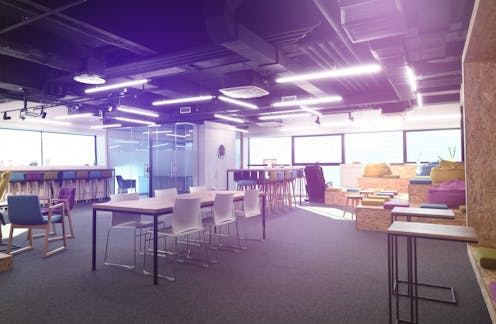Open-plan classrooms are trendy but there is little evidence to show they help students learn
- Written by Anika Stobart, Senior Associate, Grattan Institute

If you step into a newly built school these days, chances are you will see classrooms that look very different to the classrooms most of us spent our school years in as children.
On a recent visit to a new primary school in Melbourne, Grattan Institute’s education team entered a large room that contained two classes, separated not by a wall but a wide pillar that left room for teachers and students to move between the two “classroom” spaces.
In the first space, students were leaning forward at their desks, concentrating on their teacher. The room was very noisy. The teacher was only metres from her students, but her voice was all but drowned out by the second “classroom” on the other side.
This appears to be the trend in new classroom buildings around Australia.
For example, in 2017 the New South Wales government committed to building open-plan classrooms, each for up to 120 students[1], at more than 100 new schools. The Victorian government is building “new flexible learning communities[2]”.
What does the research say about open-plan classrooms?
Arguments in favour of open-plan classrooms use phrases[3] such as “21st century teaching” and “innovative design”.
The idea is to have flexible classroom spaces that can cater for large groups of students, while also allowing students to break into smaller groups, directing their own learning while receiving support from a team of teachers working collaboratively.
But there is limited evidence open-plan classrooms help learning. In 2018 the University of Melbourne published a systematic review[4] that only found 21 relevant studies since the 1960s that evaluated the impact of educational spaces on student learning outcomes. Of these, the studies showed open-plan environments had mixed effects on academic performance.
We do know too much noise is bad for learning. A 2015 Australian study[5] compared speech perception in traditional and open-plan kindergarten classrooms and found noise coming from other classes in the open-plan setting made it more likely for students to misunderstand their teacher. The study[6] found traditional classrooms were the only classroom type to be within or close to recommended noise levels.
Many open-plan learning spaces don’t align with internationally recognised evidence-based strategies[7] for high-impact teaching.
For example, explicit teaching – where the teacher explains key concepts and procedures clearly and models how to solve problems to the whole class – is difficult to do well in a noisy environment. Imagine trying to teach division of fractions to your Year 5 class while the Year 4 class on the other side of the pillar practices their Mandarin oral language presentations.
Too much noise is bad for all students
Of course, traditional classrooms can also be noisy, but a 2013 United Kingdom survey[8] of 2,500 high school students across six schools suggested students at schools with traditional classrooms were more positive about their school acoustics than students at schools with open-plan classrooms.
Too much noise is bad news for all students. But it is particularly worrying for students who have issues with hearing, auditory processing[9], and other additional learning needs, such as ADHD.
This is also inconsistent with state governments’ stated priorities of ensuring schools are inclusive spaces that cater for students with additional learning needs[10].
New classrooms should be built using evidence
State governments need to review the existing research – and seek more if needed – and ensure all new classrooms can support the learning of all students. This includes those with additional learning needs and those unlucky enough to be seated at the back of an open-plan classroom.
This is consistent with a 2022 NSW parliamentary inquiry[11] into school infrastructure, which recommended school design should follow evidence, not fads.
Where necessary, state governments should also provide schools with funding to fix existing open-plan classrooms so teachers can reduce noisy distractions. Teachers should not have to build their own classroom walls “with whiteboards and shelving[12]”.
Read more: Classroom design should follow evidence, not architectural fads[13]
Some state governments are spending significant funds building new schools and upgrading others in coming years. For example, the NSW government is spending A$8.6 billion[14] on school infrastructure over the next four years. Queensland is spending A$2 billion[15] on education infrastructure this year alone.
While investments in school infrastructure are of course welcome, the danger is many classrooms may be built in ways that undermine effective teaching. Classrooms designs should not create more work for teachers, just to make sure their students can hear them - and each other - speak.
Brigette Garbin contributed to the analysis of this piece, and previously worked as a researcher at the Grattan Institute.
References
- ^ each for up to 120 students (www.dailytelegraph.com.au)
- ^ new flexible learning communities (www.schoolbuildings.vic.gov.au)
- ^ use phrases (www.arc.gov.au)
- ^ systematic review (apo.org.au)
- ^ Australian study (asa.scitation.org)
- ^ study (www.sciencedirect.com)
- ^ evidence-based strategies (www.education.vic.gov.au)
- ^ 2013 United Kingdom survey (pubmed.ncbi.nlm.nih.gov)
- ^ auditory processing (theconversation.com)
- ^ additional learning needs (www.vic.gov.au)
- ^ NSW parliamentary inquiry (www.parliament.nsw.gov.au)
- ^ with whiteboards and shelving (www.theage.com.au)
- ^ Classroom design should follow evidence, not architectural fads (theconversation.com)
- ^ A$8.6 billion (www.schoolinfrastructure.nsw.gov.au)
- ^ A$2 billion (statements.qld.gov.au)

















